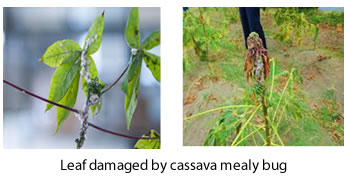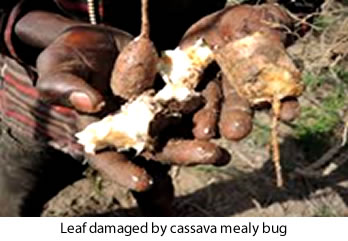
 Cassava (Manihot esculenta) [Local names: Muhogo, Omuogo, Mariwa, Marieba] is drought tolerant and produces reasonable yields under adverse climatic conditions.
Cassava (Manihot esculenta) [Local names: Muhogo, Omuogo, Mariwa, Marieba] is drought tolerant and produces reasonable yields under adverse climatic conditions.
The crop can grow well and achieve good yields in areas where annual rainfall is as low as 500 mm, well-distributed in the growing season. Water-logged, compact soils or hard pan interferes with free root development.
The crop can remain in the soil as a famine reserve for a reasonable period of time after maturity. Other factors that make cassava popular with small-scale farmers are that it requires little labour in its production and there are no labour peaks because the necessary operations in its production can be spread throughout the year, and its yields fluctuate less than those of cereals.
Altitude range
Cassava require an altitude of 0 – 1500 masl
Soil type and conditions
Medium fertile soil with good drainage with a pH of 4.5 – 6.5. Cassava nutrient requirements include: N, P, K, Ca, Mg, S, B, Cl, Cu, Fe, Mn, Mo and Zn
Temperature range
The temperatures should be 25 – 29 oC
Rainfall
The rainfall should be 1000 – 1500 mm p.a.
Steps during land preparation
- Prepare land early, especially during the dry season, preferably 2 months before planting
- Harrow to a medium tilth
- Analyse the soil and cassava nutrient requirement for various soil types.
- Add manure and fertilizers to the soil in the right amounts to provide the required plant nutrients for vigorous crop growth
Planting materials
- Harvesting of planting materials can be done 6-8 months after transplanting.
- Use only clean, disease-free planting materials from reliable and recommended sources
- Transplant/plant cuttings in a well-prepared field at a spacing of either 100 cm x 50 cm or 50 cm x 50 cm.
- Use mini-stem cuttings of 2-4 nodes in rapid seed multiplication technique
- Select a well-drained, flat site for the nursery bed, near a source of water.
- Choose a nursery bed of 1.0 – 1.2 m width, at least 30 cm high, and convenient length.
- Plant hardwood mini cuttings horizontally, at a spacing of 10 cm x 10 cm, and a depth of 4 cm to 5 cm. Place cuttings so that two adjacent nodes are on the right and left sides
- Plant semi-mature cuttings vertically at a spacing of 10 cm x 10 cm with two-thirds of the cuttings and the old ends buried
- Plant tip-shoot cuttings in the same manner as semi-mature cuttings, at a spacing of 10 cm x 10 cm. Bury two-thirds of the cuttings in the soil
- Alternatively, for rapid seed multiplication method, Plant mini-stem cuttings in strong, black, disposable bags / containers
- Perforate the bags at the sides and bottom to allow drainage, and fill with good quality garden soil; or soil-less media, following the same planting procedure as for nursery beds
Recommended varieties
Migyera, MM96/9308, MM06/0074, MM06/0131, MM06/0013, MH95/0183, MM96/1642, MM98/3567, MM96/4271, MM96/2480, MM97/0293, MM96/0868, MM06/0138, MM06/0139
Common planting materials

- Seeds
- Mini-stem cuttings of 2-4 nodes, semi-mature cuttings, tip shoot mini-stem cuttings
- Apply rapid seed multiplication method to overcome the problem of low multiplication ratio (a ratio of 1:10) in cassava planting material development.

- There are three different orientations in which cassava is planted
- Vertical position, at an angle (450-600). Vertical or angled (slanting) orientation, make sure the buds are facing upwards. Plant the stakes at an angle of 45o–60o during rainy season. Place ⅔ of the stake buried in the soil
- For horizontal planting (flat), burry the cutting 5 to 10cm horizontally so that the entire cutting lies beneath the soil. Flat position is done during dry season
- Cuttings planted vertically at an angle sprout within 7-10 days while cuttings planted horizontally sprout within 14-21 days


Cuttings planted vertically at an angle sprout within 7-10 days while cuttings planted horizontally sprout within 14-21 days

- Water the tip shoots lightly 3 times daily (Tip shoots are sensitive to low humidity).
- Keep the nursery beds weed free and cover the cuttings exposed during watering
- First weeding within the first month after planting
- Hand weeding is the most common method: remove the weeds around the plants by hand to avoid disturbing the roots and injuring the shoots
- Cover crops may also be used to control weeds
- Weeding 3-5 times in the growing season may be sufficient
- Early branching and vigorous varieties develop canopies which reduce weed growth
- Stems can be cut and supplied to farmers 6-8 months after transplanting
- Cut the stems at a height of 20-25 cm above the ground
- Harvesting of planting materials can be done up to three times
- Cut back young stems 8-12 weeks after planting of cuttings in the nursery and use the resulting tip shoots for further multiplication
- Tip shoots can be cut several times in a year to serve as a source of seeds for a long period of time
- The cut stumps will sprout (ratoon) into several shoots, allow only 2-3 to grow
- Ministem cuttings sprouted in bags without soil can be planted directly onto the field after 7-10 days. Sprouting in bags without soil has additional advantages
- Cassava can be intercropped with short crops such as grain legumes and pulses which mature in three months. Intercropping ensures maximum land utilization since mean maturity period of cassava is 12 months
- Select CGM tolerant varieties
- Cultural methods: such as adjusting planting time for the crop to escape severe damage at young age, mixing varieties to avoid genetic uniformity
- Biological control: several predatory mites such as T. aripo feeds on cassava green mites in some parts of western Kenya
- Rain drops also reduce CGM populations considerably

Control of mealy bug
- Resistant/tolerant varieties
- Indigenous technical knowledge (ITK) g. trapping, keeping fields clean
- Diversify: grow different varieties in the same field
- Biological Control using parasitic wasp (Epidinocarsis lopezi wasp)
- During heavy rains many mealy bugs are washed off their host, infestations are thus most serious during the dry season

Control cassava roots damage by moles
- Crop rotation can minimize mole damage on roots. Indigenous technical knowledge (ITK) has been used successfully by some farmers
- Fencing to control livestock damage

Management of cassava mosaic virus
- Resistant/tolerant varieties: Use cuttings from healthy plants
- Crop hygiene: Rogue infected plants
- Isolate new cassava fields from older diseased fields to minimize inoculum build-up
- Crop rotation

Management of Cassava Brown Streak Disease (CBSD)
- Resistant varieties: disease-free planting materials
- Harvest early, before symptoms reach at severity of 3 on grading scale of 1-5 in the roots
- CBSD incidence is greatest at low altitude, and the disease has been observed at 1400 m. a.s.l.

Cassava is ready for harvesting 9-12 months after planting depending on variety, and the stage of maturity is judged by the yellowing of lower leaves

- Harvesting is commonly done manually by uprooting the whole plant or piece-meal harvesting using a fork jembe / hoe
- Cassava can also be harvested mechanically, and the roots picked by hand. Harvesting is easier when cassava is planted on ridges and in loose or sandy soils; and during the wet season.
- Too early harvesting results in lower root yield and starch content while delayed harvesting leads to development of woody, fibrous roots and reduction in starch content
- Use a sharp knife to separate roots from the stem to minimize damage. Cut each as close to the stem as possible, leaving a short section of the stem attached, may help to prevent spread of decay
- Grade the harvested cassava in the field and discard damaged or infected roots
- Remove loose soil from the root surface
- Put the harvested roots under shade for sorting and grading
- Place harvested roots in strong well-ventilated field containers for transport from the field
- Wooden crates or strong plastic containers are much better field containers than sacks or reed baskets, which provide minimal protection to the roots
- Utilize cassavas as recommended: determine whether it is for boiling or processing – variety verses cyanine
- Rough handling of fresh roots can make them bitter
- Processing: Separate and process first the damaged and small roots in order to minimize the growth of moulds.
- Due to storage limitations, most farmers prefer leaving their cassava in the field and only harvest when there is need. If piece-meal harvesting is done, care should be taken not to damage the remaining roots. Also, very prolonged “in-ground” storage leads to cassava being fibrous and woody, impairs flavor, and more risk of insect, disease or rodent attack
- Transport the produce during cool part of the day, under very careful conditions to avoid damaging the produce
